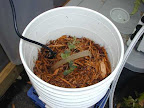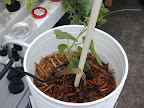It’s been quite a while since I did a pork butt roast. I usually do what is called a small or a half, typically around 4 lbs. I wanted to try to go all out and do a bigger one, and, for my household, a 7-pounder seemed about the right size to try.
A Weber Bullet owner knows his cooker is capable of not only very stable temperatures, but of maintaining them for very long time periods as well. Knowing this, a lot of Weber Bullet owners cook pork butts overnight, because, at barbecue temperatures, pork butt takes 1-1/2 to 2 hours per pound to reach the desired internal temperature of 190 to 205*F. Doing a little math, we realize that a 7 pound pork butt roast should take from 10-1/2 to 14 hours to finish.
Those unfamiliar would ask “Why so high a temperature? Pork is considered cooked well below 190*F.”
This is where we have to remind the casual observer that the aim of true barbecue is to take otherwise tough and/or fatty cuts of meat and, by cooking them at low temperatures for long periods of time, render out fat and break down tough connective tissue. Barbecue meats need to be cooked– it is said– beyond doneness to the point of tenderness.
In this case, I wasn’t interested in an overnighter, because I was not shooting to be done for a specific dinner time. Instead, I chose to get started right after Sunday breakfast– around 10:00am.
I opted to fire up the cooker using an alternate method known for maintaining long, even burn times. To accomplish this, the charcoal ring is filled full of unlit briquets, and a small amount of lit charcoal is placed on top. This small amount then slowly ignites adjacent briquets, and, eventually, the entire bed is lit– just not all at once. Some would question the advisability of cooking over charcoal that has not been fully lit, but this method in fact does not taint the food with any undesirable taste.
For my starter coals, I chose to re-light some used briquets from a previous cook. I know from experience that these used briquets burn hotter than new charcoal, and I theorized that such hotter-burning coals would be particularly suited for getting the cooker temperature up to target more quickly.
Those familiar with good barbecue are acquainted with the concept of a smoke ring, which is the reddish coloration the edge of the meat takes on when smoke-cooked. A chemical reaction takes place, but only within a specific temperature range, and then stops once the high end of the range has been exceeded, which explains why this “ring” only penetrates the meat a fraction of an inch. Therefore, in order to form a pronounced smoke ring, one must apply smoke to the meat while it is in this specific temperature range, between 40 and 140*F.
Some observers familiar with true barbecue would ask, “If you’re going to do a long cook like a pork butt, why not let the meat come to room temperature before cooking, like I’ve heard some people do?” My answer would be two-pronged. One, you would not want to let raw meat sit off refrigeration for too long due to food safety concerns. Second, even if you set a sizeable pork butt roast out for a couple of hours, the mass of the meat would not allow its core temperature to rise appreciably.
Another thing barbecue cooks know is that, when a large piece of meat is placed into a hot cooker, the temperature will drop considerably because of the cold mass introduced into the chamber. To address this issue, I decided to try something different.
Typically, the firing and set-up of a Weber Bullet or similar cooker involves lighting the fire by some method, and also introducing a temperature-stabilizing heatsink. In the case of the Bullet, the standard heatsink is the water-filled pan below the cooking grates.
Some Bullet owners, in a effort to avoid spilling water on hot coals or to facilitate clean-up, have switched to using sand in the pan. There is some debate as to whether sand is better than water as a heatsink or not. The pro-sand camp cite the reasons just stated, adding that sand– unlike water– does not need to be replenished like water does. The traditional water camp, however, would point out that sand continues to absorb heat far past the 212* point water does, and it (sand) can therefore become an undesirable radiator of heat over time.
So, my different approach for this cook went like this: I wanted to put the meat on right out of the refrigerator to maximize the smoke ring. But, I didn’t want to fight to get the cooker temperature up to my target any longer than I had to. So, I theorized that, if I began cooking with no heatsink, the overall mass available to absorb heat initially would be limited to only the meat itself. My plan was to leave the pan empty until the cooker temperature had come reasonably close to my target, and then add very hot tap water to the pan.
Long story short, it worked perfectly. Even cooking on a cold 57* day, with light wind, my cooker hung at a stable 250* for 13 hours, with fuel to spare.
Once I reached 150* meat temp, I foiled the roast since I knew it had received plenty of smoke, and was past the point of further smoke ring formation. Once the roast hit 198*, I pierced a few holes in the bottom of the foil to let rendered fat drain into the water pan. I continued to cook until I achieved a final meat temperature of 205*.
Once remove from the cooker, I rested the still foil-wrapped roast for about 15 minutes. Upon unwrapping, the bone pulled cleanly from the meat with no resistance whatsoever. I used two carving forks to easily shred the still very hot meat into pulled pork. The net from the 7.17-pound roast weighed right at 4 lbs.


